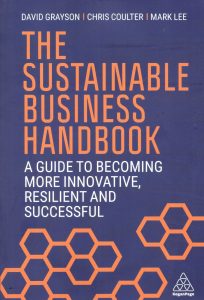The one-sentence summary
In a world where climate change affects supply chains and customer expectations require businesses to take action, organisations can no longer ignore the issue of business sustainability because it drives innovation, brand value and profit.
Can’t be bothered to read it? Listen to the 5-minute podcast in 2 parts.
WHAT THE BOOK SAYS 
- This is a guide to help businesses become more innovative, resilient and successful. The book has three parts:
-
- Getting started: purpose, materiality, the business case
- Building it up: strategy, operationalising, culture, leadership, reporting, governance
- Taking it to the world: engagement, communications, partnering, advocacy
- To make the most of purpose, companies need to review corporate assets and history, engage with stakeholders, craft the purpose statement, ensure that the core business strategy is aligned to it, socialize and communicate it, and measure impact.
- The Said Business School has produced a SCORE framework for embedding organizational purpose: Simplify, Connect, Own, Reward, Exemplify.
- The term materiality comes from the accounting industry, relating to the disclosure or omission of information that could have important consequences for the financial value of the company. In this context, it refers to the process of identifying, defining and prioritizing sustainability or ESG issues for a business. A materiality matrix maps impact on society and the environment alongside impact on enterprise value, enabling a company to determine its most pressing ESG/sustainability issues. (The rise of the ESG agenda leads the authors to regard the term as a synonym for sustainability.)
- Sustainability or ESG governance is defined as: the formal process established by the board of a company to ensure oversight of the company’s responsibilities for its social, environmental and economic impacts and to guarantee that a company’s specific sustainability commitments are met.
- Building a business case involves applying existing, external data and evidence, examining company-specific evidence and benchmarking with peers, and creating cross-functional teams to provide relevant case data to different stakeholders.
- Effective reporting involves clarifying some basic reporting questions, studying and choosing preferred options from among the major reporting guidelines and frameworks, collecting the data diligently, reporting and making full use of it, and learning from the process to innovate further.
WHAT’S GOOD ABOUT IT
- Benefit corporations (B Corps) balance purpose and profit by considering the impact of their decisions on workers, customers, suppliers, community and the environment.
- The correct attitude for such a company is to have an enduring mindset that regards sustainability as both risk mitigation and opportunity maximization.
- Organizations need to make clear how they want to be behave. Speaking up when things aren’t right is essential, and companies should develop ethical leaders at all levels, not just the top.
- Communicating sustainability is not only about sharing information, news or progress regarding a company’s sustainability strategy or performance. It is also about building belief, recognition and momentum for its sustainability leadership, which ultimately helps build trust and supports the business case for sustainability- or ESG-related investment and effort. All of this leads to increased equity in reputation, the brand, and talent.
- The Five Cs of sustainability communications are: Clear, Credible, Complete, Compelling and Customized.
- Corporate advocacy involves speaking out and speaking up for social and environmental progress. It is not self-interested lobbying. Businesses need to determine if they have the authority to advocate for sustainability, develop a framework or decision tool to help them decide whether to speak out on a particular topic, define their advocacy objectives, clarify their target audiences, and keep reviewing what they do to see if it still holds up.
WHAT YOU HAVE TO WATCH
- Being a handbook, the emphasis is on practical process rather than inspiring examples.
